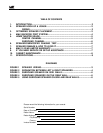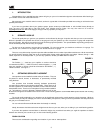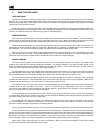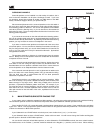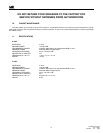
When you are operating your speakers as Full Range Vented Box speakers, taking advantage of the M&K Backfire Port system,
you will hear maximum bass and low frequencies when the speakers are located within a few inches of a wall or the back of a
cabinet. See Section 4 below for more details.
When you are operating your speakers as Sealed Box speakers, it is not necessary to locate them near a wall. In fact, you will
probably find that the sonic imagining of the speakers improves as you move the speakers away from room surfaces.
You will also find that the imaging improves when the speakers are away from room surfaces when operating them as Full Range
Vented Boxes. In either case, please feel free to experiment to find the best sound in your room.
SEPARATION BETWEEN LEFT AND RIGHT SPEAKERS
Here is a formula for achieving the ideal left to right stereo
imaging. Think of a triangle formed by the locations of the Left
and Right speakers and your listening position. Ideally, the
subtended angle formed should be between 45 and 50
degrees. Roughly, this means that the Left and Right
speakers should be separated by about the same distance
that you are sitting back from the speakers. In other words, if
the distance from your listening position to the point directly
between the speakers is 10 feet, place the speakers so their
centers are 10 feet apart. See Figure 2.
On Figure 2, the length of line A - B should be about the
same as the length of line X - Y. (They may not seem to be
the same in this diagram due to an optical illusion).
Try to follow the formula as close as you can. You can
fine tune the placement by listening to a source with an image
(such as a vocalist) centered between the speakers. When
listening in stereo (no Center Channel speaker), move the
speakers closer together or farther apart in small increments
until you hear the sharpest and most cohesive image,
especially in the phantom center. You may also want to angle
(or "toe-in") the speakers slightly. This often improves the
sharpness of the stereo image, reduces room colorations, and
provides a wider seating area. The angled front baffles of your
speakers also provide this benefit.
4. M&K BACKFIRE PORT SYSTEM (rear of cabinet)
On the back panel of the speaker is the M&K Backfire Port. Inside its plastic tube is a plug that can be easily removed or
inserted. DO NOT THROW THIS PLUG AWAY. This plug can be used to adjust the performance of the speaker to fit your system
needs or personal preferences.
When the plug is inserted into the speaker cabinet, the plug seals the speaker port, making it a SEALED BOX speaker. When
the plug is removed from the speaker cabinet, the port is open, making it a VENTED BOX speaker. When the speaker is used as a
vented box speaker, the 1500 and 1600 operate as FULL RANGE speaker. Here are the advantages and disadvantages of each
mode, with recommended applications. Feel free to experiment with both configurations to see which one you prefer.
FULL-RANGE VENTED BOX - UNPLUG AND PLAY! (Plug removed from port):
Removing the plug increases the bass output of the speaker. This is recommended when the system has no subwoofer.
The vented box configuration generally gives the most satisfying bass when the speaker is being used as a full-range
configuration. When you are not using a subwoofer, the plug should be removed. The M&K Backfire Port system is most
effective when the output of the port couples to a room surface (such as the back wall). You will hear the greatest bass
output from your speakers when they are located close to the wall. Feel free to experiment for the best sound.
SEALED BOX (Plug inserted in port):
If you are using a subwoofer with your B-1600 or B-1500 speakers, operate them as sealed boxes. This will give you the
best transition of sound between the satellite speaker and the subwoofer. If you are using a high-pass filter (BMC-MINI), you
must operate the speaker as a sealed box in order for the filter to operate optimally.
4
X
Y
A
B
Aim the speakers
at the primary listener.
Line X - Y should equal
line A - B.
(Line A - B appears longer
in this diagram due to an
optical illusion).
FIGURE 2




